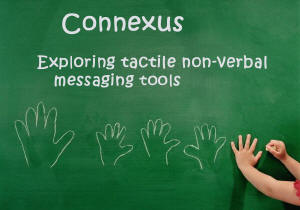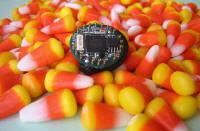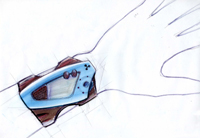

 |
|
|
INTRODUCTION |
|
 |
Human communication and interaction is comprised of a wide range of verbal and non-verbal cues. Further adoption of novel tele-communication methods such as email, chat, instant messaging (IM), mobile phone SMS text messaging, and videoconferencing; have augmented our mediated interaction abilities. However, a significant (and important) amount of human expression and interaction information is never captured, transmitted, or expressed with current computer mediated communication (CMC) tools. We also lack ambient methods of maintaining contact when not co-located with family and friends. Intimate Computing is a new research effort aimed at the study of intersection of proactive computing and human intimacy. One vector of Intimate Computing is the study of non-verbal human cues, their intent, motion, meaning, subtleties, and importance in communication. This research addresses issues involved in the design, construction, and evaluation of Connexus, one such Intimate Computing device. |
|
PROCESS |
|
 003F_small.jpg)
|
We initiated our exploration of this research area by watching non-verbal interactions of co-located people who had prior established relationships. These observations primarily occurred at public markets, shopping districts, parks, sporting events, and on public transportation. The results point to a fundamental human urge to maintain some open communication channel between friends and loved ones at almost all times when co-located.
We also noted a high degree of reaching out with simple hand and body gestures to connect to the other individual. Often we observed directed glancing. Rather than to establish direct eye contact it occurred more often for simply checking on the other individual’s location, activities, and attention. What’s important to note is that this ambient awareness technique was rarely used as a method to initiate further direct communication. There was sufficient satisfaction in simply gaining some knowledge of the other person’s state of being. We speculate that this activity serves an important role in the development of human relationships.
|
|
|
|
|
Early design I/O for Connexus |
|
|
SENSING |
|
|
Rather than overwhelming the user with sensing we chose a few reasonable sensing modes that were readily available. These design decisions were driven by the initial user studies performed. While we admit that we may not have chosen optimal sensing modes, we were more interested in moving towards a prototype that we could begin evaluation on rather than exhaustively iterating through sensing technologies. Force sensing resistors provide pressure detection over a high resolution surface array on the top of the Connexus. This allows for simple touching to be sensed. By time stamping the sensed data, rich signals such as a user swirling their finger along the surface of the Connexus can be detected. The sensor can detect XY position and pressure data. Ambient light is easily sensed with a photocell. As a user moves inside, outside, or places their hand over the Connexus, a signal is generated. A small heartbeat sensor allows detection of an individual’s pulse. This provides access to a personal "life signal" of another person. We have explored several other input methods and are currently developing prototypes around them. |
|
ACTUATION |
|
 |
Similar to the sensing, we simply chose a few reasonable actuators to provide a sufficiently interesting set of output modes. When electrical current is applied to a Peltier Junction, a temperature difference is created with one side of the thermocouple being hotter than room temperature, and the other being cooler. This allows the Connexus to heat and cool the skin it is contacting. Using an array of superbright LEDs, we are able to output a range of subtle glowing colors not unlike a typical mood ring. Intentionally avoiding literal text, we were able to explore innate human responses to illumination and color. Simple vibrations are easily and privately felt though skin contact. Various vibration patterns and duty cycles provide a number of output possibilities for the Connexus. We used simple flat pancake vibration motors to induce vibration. Several other output technologies have also been developed and are being evaluated in user studies. |
|
DEVICE |
|
|
|
|
 |
A Connexus is a small, simple, wrist worn personal object augmented with simple sensing, actuation, and ad hoc networking support. The focus was to design a system that would allow exploration of how humans would communicate when not co-located without the use of text or speech. The basic idea was to create a small collection of sensors to capture information from one end and transmit them to the other end for expression using various actuators. Rather than creating a fixed mapping of senor to actuator, we were motivated to explore the interaction “language” that would evolve through individual user driven personalized mappings. This design choice was inspired by the language of numerical codes that resulted from early pager usages and re-appropriation.
|
|
SCENARIOS |
|
|
|
|
|
DESIGNS |
|

|
|
|
|
|
|
PAPERS |
|
 |
|
|
NEXT STEPS |
|
 |
We are currently developing a second generation device to be used in user studies in the next few months. We are eager to potion the technology into other settings as well. Updates will appear on this webpage. |
|
ACKNOWLEDGEMENTS |
|
 |
Many people provided valuable
insights, feedback, and assisted in various parts of this research
project. We'd like to thanks several individuals below:
|
![]()